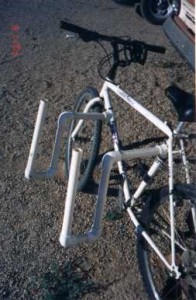I've never been too keen on guns. Now, I'm not one of those people who thinks that getting a gun can turn someone into a mass murderer or serial killer. (It seems that about 95 percent of the people I've met in the academic world believe something like that.) Two of my uncles were hunters; I simply never had any desire to join them. And, although I had firearms training in my youth, I have never had any inclination to own or use a firearm.
Most of the cyclists I know aren't gun enthusiasts, either. I've known one cyclist who shot for sport, but only at inanimate targets on designated shooting ranges. Other than that former riding buddy (a woman, actually!), the worlds of bicycles and guns have never, in any way, intersected for me.
What I just wrote would astonish or confound a cyclist of the 1890's. Then, not only was it common for cyclists to carry "pieces" with them; it was more or less de rigeur. And, Sears and Roebuck as well as other retailers offered revolvers, pistols and rifles designed especially for cyclists!
What's more, a few companies, such as Iver-Johnson and, yes, Smith and Wesson (!) actually made both guns and bikes. The cities in which most firearms were made, such as Worcester, Springfield and Fitchburg in Massachusetts; Hartford, CT and Paterson, NJ, were also centers of the bicycle industry.l Similarly, Birmingham and St. Etienne also were the capitals of bike- and gun- making in England and France, respectively. (They were also the centers of their nations' steel industries.)
As best as I can tell, guns made for cyclists differed from others in that they had shorter barrels so that they could fit into jacket or vest pockets. Also, firearms for cyclists had mechanisms that prevented them from firing accidentally. It would be an especially important feature, I think, for those who mounted "penny farthings" or high-wheelers, as riders tended to fall off them more often than those who pedaled "safety" bicycles.
The connection between firearms and bicycles extends, not surprisingly, to bicycle components. Machine guns first became part of warfare during World War I. A French soldier would study their mechanisms and use them as the basis for what remains, to this date, one of the greatest innovations in cycling: Le Cyclo derailleur, which Albert Raimond designed and began to manufacture in 1923. It is said to be the first reliable and practical derailleur made, and was seen on tandems in England into the 1970's. Raimond would move to England and, with Louis Camillis, founded the British Cyclo gear company. Their freewheels and other parts (including the derailleur, which became the Cyclo Standard) owed much in their designs and manufacturing techniques to the armaments used during the so-called Great War.
 |
| Cyclo Standard derailleur, 1930's. From Disraeligears. |
Today, few people make any connection between bicycles and firearms or warfare. But, for better or worse, the development of the bicycle and that of firearms were once inseparable. I wonder how our bikes today would ride, shift and brake had they not been such a relationship between wheels and revolvers. Would frames have brazed-on brackets for carrying short rifles? Hmm...










BQNnKBRVl!~~60_57.JPG)










